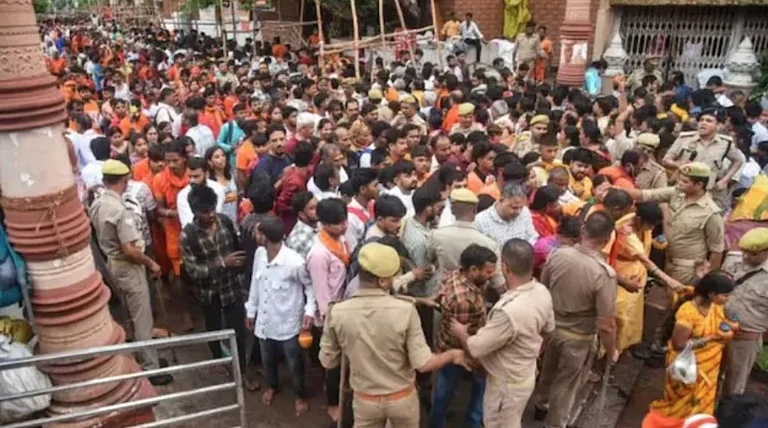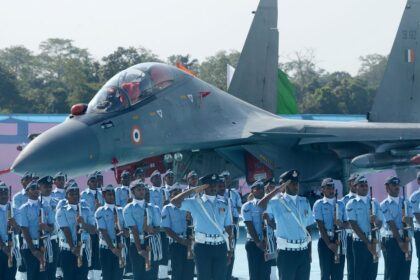A Tragedy of a Holy Morning in Barabanki
The morning that had started so holy, so spiritually meaningful, in the district of Barabanki, at Haidergarh was to see a conclusion filled with heartbreak and confusion. The centuries-old Avsaaneshwar temple at which hundreds and thousands of pilgrims gather every year during the holy month of Shravan caused a stampede -like panic Monday morning where two people lost their lives and over 30 injured.
Devotees had congregated in full strength to perform jalabhishek, a highly sacred act of pouring of water on Lord Shiva, on the third Monday of Shravan, a spellbinding month in Hindu religion in North India. But a mischance involving the busted electric wire brought about chaos causing holy land to be a place of a stampede.
Chain of Events: A monkey, a Catastrophe
Early reports by the district officials cited that the reason behind the panic was due to a strange and sad episode. A monkey, usually found in temple premises, is said to have climbed on a live electric wire around the temple area. The wire had become old and strained already, hanging perilously over a tin shanty, breaking under the weight and dropping down on the metallic roof.
When the low-hanging live-wire made contact with the shed, the building began to become heated with the flow of electric current. Suddenly, the devotees standing close to the electric shock device got a quick shock because they were not aware of the danger. Shouts of agony and fright were heard and a great stampede to get out of the place was evidence of the trouble. At least a few devotees were trampled in the ensuing melee, and the narrow temple corridor narrowed to a bottleneck pathway of escaping pilgrims.
Casualties and Medical Response
Police in one of the districts affirmed that two of them died during treatment. One has been a 22-year-old Prashant of Mubarakpura village and a 30-year-old devotee name yet to be announced died at the Trivediganj Community Health Centre (CHC).
A total of 32 supposedly injured persons were reported in the melee. 10 were referred to Trivediganj CHC and 5 of them were subsequently referred to other institutions with a stronger medical capability because of their critical cases. And in 26 other cases, treatment and care have been provided at Haidergarh CHC and at least one of them has been transferred to a hospital with advanced care.
Swift Administrative Response and Chief Minister’s Reaction
Yogi Adityanath, the Chief Minister of Uttar Pradesh, mourned the human loss and tasked authorities to speed up relief operations and rescue. Adityanath also ordered the injured to offer the best possible medical care in an official statement of the Chief Minister Office (CMO).
The Chief Minister noticed the incident and instructed the officers to go to the scene immediately. The injured should be treated in proper arrangements. The CMO said everyone in relief efforts must be fast-tracked.
After the incident, District Magistrate Shashank Tripathi and other senior police officers landed on the scene. Security was tightened, and an electrical safety audit of the temple was undertaken. To maintain order, police officers were also used to control crowds.
A Shravan of Overcrowding and Growing Safety Concerns
Such a mishap in Barabanki is not the only one. It happened only a few days after a similar stampede-like scenario at Mansa Devi temple in Haridwar, Uttarakhand, where six people lost their lives in the Shravan rush. Collectively, it poses serious concerns regarding crowd control, building safety and emergency response facilities at places of worship.
Spiritually it is a great month because it relays into the spiritual life of the devotee, but it is a logistical and safety nightmare to the local administration. The potential dangers in temples with large human crowds in North India, particularly on Mondays that are deemed special days by Lord Shiva, are aggravated by the lack of safety measures and old infrastructure.
Infrastructural Fragility and the Monkey Menace
The locals and the volunteers of the temple have cited that the electric wiring at the Ausaneshwar temple was in a bad shape months ago. There had (reportedly) been several complaints about the closeness of exposed wires to metal sheds and about monkey activity in the vicinity but no precautionary measures had been taken.
Although monkeys are regarded as sacred creatures in Hindu since they worshipped Lord Hanuman, they have been increasingly becoming a menace during religious events. They can cause more accidents as they come close to the overhead cables and food stalls. In city and semi urban temple complexes where the electricity infrastructure is obsolete and very little care is given to the temple complex, the presence of animal activity coupled to the density of the crowds is a time bomb waiting to happen.
Voices from the Ground: Survivors Speak Out
One of the believers, who was present during the incident, a 41-year-old Savitri Devi of Raebareli described how panic struck her.
It was just like that. I heard something like a snap and then people began to scream. I seemed to get almost an electric shock in my hand, and here I knew it the ruck behind was beginning to push. I said to her, sitting in a hospital bed with a broken ankle, we just ran.
The event was characterized by another survivor, a 17-year old school student Ravi Yadav, as a case of complete madness.
“And there was no way of getting out. Farther and farther people fell. I had witnessed an elderly lady being run over and attempted to yank her out. I had been yanked away by my arm and I simply fled.”
Aftermath: Worship Resumes, But Concerns Remain
By afternoon, religious events had picked back up again at the temple with a noticeably smaller throng. Priests also prayed over the loss of lives and those injured, in the local churches. Nevertheless, the atmosphere was tense and worshipers were observed going around the grounds with caution.
The temple authorities have assured that they will cooperate with the probe. District administration has meantime demanded a technical inspection of the electric grid covering the temple to determine structural safety, and an evaluation on whether to reroute high-risk electrical lines to determine feasibility.
Lessons for the Future: Managing Faith and Safety
The disaster at the Ausaneshwar should serve as a sore reminder that not even holy grounds are exempt to destructive forces when infrastructural and management resources fall behind the rising number of pilgrims.
With temple-based pilgrimage and spiritual travel catching on in India once again, the need of the hour was to make security planning a part and parcel of the event. This includes:
- Electrical safety audits Comprehensive
- Training of appointed crowd management personnel
- Surveillance system mounted to detect early surge of crowds
- Clear emergency evacuation procedures
- Procedures in regard to monkey control, and interaction with wild animals, concerning temple areas
The Victims: Lives Lost in the Midst of Faith
The two identified dead people were:
- Prashant (22 years old) belonging to Mubarakpura village falling in the jurisdiction of Lonikatra Police Statio
- The unknown male cult member was of approximated age of 30 years old
They died of their injuries in the Trivediganj Community Health Centre (CHC), where they had been brought by passers by and local helpers. Although some of the reports say that they died as a result of electrocution, others attributed the deaths to internal trauma and stampede injuries.
Among the injured 10 persons have been admitted to Trivediganj CHC including five in a critical condition. One of them was subsequently taken to the King George Medical University (KGMU) in Lucknow after suffering a lot of internal bleeding. In the meantime, 26 other victims were taken to Haidergarh CHC, a few are under observation.
Emergency Response: Late but Decisive
According to witnesses, local villagers and temple volunteers were the initial responders and they removed the injured using stretchers, bedsheets and even wooden planks. One eyewitness said: There was no ambulance at all for at least the first 20 minutes. We did not have time to delay or more lives would be lost.”
The district authorities, fire services, and police arrived before the main panic had subsided; nevertheless, they caused damage beforehand.
The office of the Chief Minister (CMO) was quick to confirm that CM Yogi Adityanath had noticed the incident and had ordered:
- Immediate sendings of district officers to the scene
- Accelerated health care of the wounded
- A thorough security check of all the religious places that anticipate high crowds during Shravan
- Report on the failure on management part, in case any, by the administration of the Barabanki district
The Chief Minister issued a public circular condoling with the families who lost their loved ones and termed the matter as unfortunate, preventable and worthy of serious consideration.
The Bigger Picture: Devotion Amid Danger
The Ausaneshwar accident is not the only tragedy of this kind and it is not the first. India has been grappling to handle mass gathering on a religious context, particularly in the season where the traffic is heavy like Shravan, Navratri, Kumbh Mela and Diwali. In less than 30 days:
- July 12, 2025: Six pilgrims in Mansa Devi temple Haridwar stampede die
- July 4, 2025: Fainting of three women at Kashi Vishwanath temple, Varanasi because of overcrowding
- June 4, 2025: More than a dozen people injured in RCB event stampede at Karnataka
Patterns of all incidents have something in common overcrowding, inadequate infrastructure, absence of trained emergency officers, and improper management of crowd flow.
Whereas devotion in the masses is an emotional and cultural attribute of Indian culture, infrastructure frequently cannot keep up with current-day pilgrimage requirements. Numerous rural shrines such as the Barabanki one are understaffed, have inadequate electricity with respect to safety, and have to deal with an enormous crowd of volunteers without proper training.
Viral Outrage and Digital Reactions
As in the case of numerous other tragedies nowadays, the video of the event spread like wildfire. There were videos of worshipers shouting, collapsing, and others attempting to use water to bring back senses to unconscious victims. Some footage demonstrated the monkey in the power line just before the wire broke. After half a day, such hashtags are found:
- #BarabankiTempleTragedy
- #AusaneshwarStampede
- #TempleSafetyNow
had been going viral on platforms such as X (previously known as Twitter), Instagram, and Facebook and Threads.
Online readers carried the sentiments of pity and anger. And it seems another year is just another tragedy. When will all the safety be given to the rural temples and places?” enquired one post. Others receive Foreign stricter State Electrical Board prescriptions and crowd control SOPs.
Worship Resumes, But Faith Shaken
It was indeed a horror-stricken morning but the worship in Ausaneshwar temple continued later in the day. Some priests held prayers to the dead. Believers came with sacrifices and expectations yet the atmosphere was somber. One long old woman said: We trust this. Today I looked right in the face of death.
To a certain extent, this silent adaptation speaks of the power of belief as well as the precariousness of security in a holy place like an Indian temple in the modern day.
Lessons to Learn: How Many More Must Suffer?
The Barabanki tragedy gives India a reason to introspect. A large proportion of Indian cultural identity and local economy is represented by religious tourism and pilgrimages. However, there are some simple requirements, such as:
- Insulation of electrical lines
- Marked exits/entries points
- Crowd flow simulation
- First-aid booths in the field of medicine
- Real-time alarm systems
are lacking in the majority of small and mid-sized temples. Technology can be of assistance. Future disasters might be averted by the use of CCTV-based crowd analytics, thermal monitoring, AI-facilitation of threat detection, and systems that offer SMS alerts, yet only when governments are willing to place safety above sentiment.
The Vue Times Editorial View
As a society, we have to prevent making death a cost of commitment. The tragedy in Barabanki is an inhumane lesson that the sacred and the dangerous can collide when there is negligence of the safety of people.
May this not be either a viral post or a breaking news alert. Be it the final time when that happens, and change is implemented. The deaths at Ausaneshwar temple are worth more than our tears, they need our action.
In Memory:
Prashant (22) and another unnamed devotee, your lives were lost in a place meant for peace. We pray not only for your souls but for a safer future for millions who worship as you did, with faith, hope, and love.
Latest Update: What Happens Next-The Vue times
- A preliminary case has been registered by police and they would investigate as to whether the incident took place as a result of negligence on part of electrical authorities.
- A committee at the district level has been established to see the preparedness protocols at the temple.
- The state government is expected to announce compensation.
- According to the sources in the administration, within 15 days, a statewide safety inspection of religious institutions is likely to be held.
What You Can Do
If you are planning a pilgrimage during this Shravan season or beyond:
- Stay alert to electrical poles and unstable shelters
- Follow crowd movement cues; avoid bottlenecks
- Travel in smaller groups whenever possible
- Report unsafe conditions to local or temple authorities
- Carry personal medical information and emergency contacts
A Tragedy Rooted in Neglect
The Indian society has a strong faith in it and, during Shravan, millions of people go to the temple to seek blessings and relief. However, the results can be not only physical, but spiritual as well when normative breakdown can threaten the sanctity and safety of these spaces.
The Ausaneshwar temple incident should be used as a starting point, not only to create a quick patch-up operation or to give compensation, it should also lead to a rethink in safety standards when it comes to religious congregations in India. It is only when we do so, that we will make our sacred places havens, and not objects of sorrow.
The Vue Times expresses its deepest condolences to the families of the deceased and prays for the speedy recovery of the injured.
For ongoing updates on this story and other national developments, stay tuned to The Vue Times.










